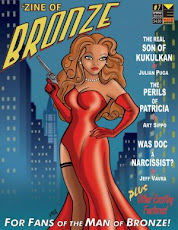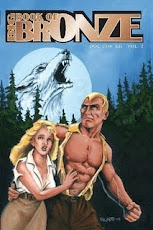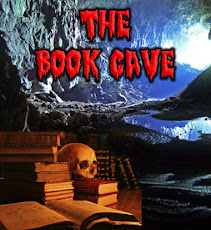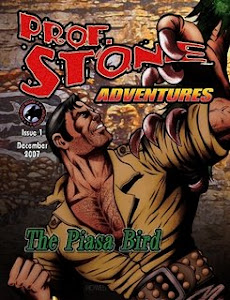 Doc and Princess Monja
Doc and Princess MonjaOver the years, Doc Savage has met and dated many beautiful women. In the Super Sagas, he was more inclined to do so in the 1940s than he was in the 1930s. His brief affair in 1918 with Lily Bugov, the Countess Idivzhopu, in Philip José Farmer's "
Escape form Loki" is the most notorious such encounter. But there was Rhoda Havens in "
The Freckled Shark"(to whom Doc as Henry peace proposed), "Z" in "
The Mental Wizard"(whom Doc almost married), Sis Harrison in "
The Talking Devil" (the daughter of a villain, but Doc took her to dinner anyway), and the beautiful Russian spy Seryi Mitroff from "
The Red Spider" (aka: "
In Hell Madonna") and "
The Frightened Fish" (with whom Doc was getting
very serious). There were also others in the Sagas.
We have also discussed his relationship to Bethany Abigail 'Abby' Johnson
earlier in this blog. Then there was the doxy, Danielle Bouvier, from "
The Devil's Thoughts" who vamped both Clark Sr. and Clark Jr.! Less well known was his fiancée Annette Bachelor who attended medical school with Doc at Johns Hopkins in the 1920s (that being another blog entry in the making).
And despite PJF's suggestion, there is no evidence that Doc and his second-cousin Patricia were ever romantically involved.
But through it all there was one woman who was a recurring character in the Super Sagas and who had always idolized Doc. I am speaking of Princess Monja F'Teema, Daughter of King Chaac, from the lost Mayan civilization of The Valley of the Vanished. The
Doc Savage Chronology at Win Eckert's
Wold Newton web site has her being born in 1915. This means she was 15 years old at the time of the events in "
The Man of Bronze". Doc at that time was 29. While Monja may have been well developed and nubile in 1931, she was still jail-bait!
In 1936 when "
The Golden Peril" occurred, Monja would have been just 20 years old. By 1942, when "
They Died Twice" occurred, she would have been 26. At that point it would have been hard for Doc not to notice Monja as a woman, especially since he was more inclined to do so in the 1940s. And indeed his distraction because of her beauty is mentioned several times in the story.
While it was a romantic notion harbored by many fans that Doc and Monja would eventually get together, there were several problems. First of all, Doc remembered his father's marriage to the Mayan maiden, Itza. It had been a true social nightmare for her to come and live in racist America where Blacks, Indians, and even the Irish were looked down upon. Itza also was uneducated by American standards and could not speak English very well. Monja also did not speak English and had no experience of the outside world.
We then have the problem of Monja's safety. Early on, Doc had discovered that his enemies would try to get to him by attacking a loved one. (This was mentioned in the George Pal movie "
Doc Savage: The Man of Bronze" where Doc actually tells "Mona Flores" that he once was engaged but that criminals kidnapped his fiancée. I have since discovered that this is a true story about an incident involving Annette Bachelor. But more on that in another blog!) . Monja would be safe in The Valley but Doc could not just stay there with her. His life work required that he travel the world. What kind of husband could he be to her if she was hidden in a secret place that he rarely visited?
Finally, we must remember that Doc was an extremely unusual man with a towering intellect and great physical prowess. Could a native Princess from the jungle really be as much of a helpmate to him as Brenna and Abby had been to his father?
But then there are the positives. Monja was head-over-heels in love with Doc from the moment she first saw him. She was determined to save herself for him and she had still not married in 1942 waiting for him. She was absolutely gorgeous with natural beauty and intelligence. She also was the only child of King Chaac. If Doc married her, he would be eligible to be her consort and thereby King of the Mayans! That would have sealed the deal on the gold in The Valley of the Vanished permanently. And she was isolated enough in The Valley that her safety would not be an issue.
We are told in "The Bridge of Light" that a missionary priest was going to The Valley to instruct the natives in the Catholic faith. The man the Bishop sent was quite familiar with the Mayan languages. He started a school for the children of the valley and taught them to read and write in Spanish. The curriculum included Spanish literature, math, science, and history along with religious instruction. Monja attended this school and so she had at least a basic grammar school education. Select students also were taught Latin and other subjects. Monja was among these.
In "
They Died Twice", it states that the Mayan natives' basic tongue was Nahuatl. This cannot be correct. Nahuatl is the primary Aztec language and is not related to the Mayan family of languages.
It is possible that some Nahuatl was spoken in The Valley. My sources tell me that there were families from various non-Mayan ethnic backgrounds who had apparently come to The Valley seeking refuge in the 17th Century when the High Mayan resurgence occurred. They had preserved their languages within their families and some of their story cycles and literature.
But the primary language spoken in The Valley was Itza Maya (Itzaj), a rare dialect spoken today by less than 100 people outside of The Valley. It is related to Yucatec Maya which is a language quite commonly spoken among ethnic Mayans in Mesoamerica. The Itzaj and Yucatec languages have a common ancestry but are somewhat different. The relationship between them is analogous to that between Italian and Spanish.
Sadly, the priest was killed by the Mayan warrior, Morning Breeze, using the Red Death a few weeks before the events in "
The Man of Bronze". At that time the Bishop of Blanco Grande had not yet named a successor. Doc spoke with the Bishop and was able to have a Jesuit, Fr. Carlos Sanchez S.J., sent there to run the mission. Fr. Sanchez was a Mexican Mayan scholar who was living in exile in Spain after being ousted by the anti-clerical government in Mexico. He wanted to do missionary work with native people and had been a missionary in Mexico before his exile. When he came to The Valley he could not believe his luck. He compiled the most complete Mayan Glyph dictionary to date. and set out preserving and recording stories and writings from all the Mesoamerican cultures that had been saved in The Valley.
He also reopened the school and taught all the basic subjects including reading and writing. The languages taught were not only Spanish and Latin but English as well. Doc made sure that it was well stocked with modern textbooks. Monja was the school's star pupil. She had a flair for languages and Fr. Sanchez began tutoring her in Greek, French and German. By the time of the events in "
The Golden Peril" Monja was ready for college studies. Fr. Sanchez was very progressive and saw educating the Princess as a way of guaranteeing the success of his religious mission. The civil war in Spain made it impossible for her to study in Europe and Mexico was in the midst of internal disturbances with open persecutions of Catholics. Many of Fr. Sanchez's friends and colleagues had been martyred for the faith in Mexico in that decade.

 The University of Cordoba, Cordoba, Argentina
The University of Cordoba, Cordoba, ArgentinaSo Fr. Sanchez arranged for Monja to attend the Catholic University of Cordoba in Argentina as a foreign dignitary. It had been founded by the Jesuits in 1613 and was the oldest university in South America. As a woman, she was not allowed to formally enroll, but she audited several classes and was privately tutored by the University's professors. She also did quite a bit of independent study. She was most interested in governmental theory and economics. With her language skills she was able to read the classics of Western Literature in their original languages. She apparently learned Italian just so she could read
La Divina Comedia in Dantte's original Tuscan dialect.
And her education went beyond books. She learned about industry, motor cars, radio, telephones, newspapers, and the night life of the modern Twentieth Century world. She also became fascinated with western art and took up painting herself. The Princess traveled all over the Americas including some trips to the USA. On at least one of those trips, she visited with Doc in New York. She spent the Summer of 1938 touring Europe. Sadly, because of the Spanish Civil War, she would not get to visit Spain until after World War II.
At the time of "
They Died Twice" Monja had just returned home from Argentina when the High Mayan -- scandalized by her studies abroad and other aberrations he blamed on Doc Savage -- clamped down and tried to return The Valley of the Vanished to its isolationism. He had forced King Chaac to imprison Fr. Sanchez just days before the events in the story. Doc soon defused the situation and, afterwards, had the opportunity to get to know Monja, the educated woman. He was aware of her studies abroad which had been financed by the Hidalgo Gold Syndicate in Blanco grande. He was duly impressed. She discussed her vision for her people in The Valley. She was concerned that their way of life was threatened by modernization and she was not pleased at the prospect of the The Valley becoming the target of modern vices. In many ways her views were much like those of the High Mayan! But she also knew that they could no longer ignore the outside world. And she was determined to fight the sexist bias she had encountered in Argentina and in her own culture. It was intolerable and wasted the talents of half of the adult population. Meanwhile, she had also developed a taste for Jazz and dancing in nightclubs.
Doc smiled to himself wistfully. He was falling in love with Monja. She reminded him of Annette, who had broken with convention and suffered numerous indignities to earn her medical degree from Johns Hopkins. Nevertheless, she was all woman and enjoyed a good night on the town. Sadly, Annette had become a target for his enemies and she was too head-strong to take a low profile. She had her own career and insisted on pursuing it without restriction. That was why Clark knew he had to break it off with her. It had been for her own safety. Would he now have the same problem with Monja?
Monja insisted that she wanted to know how the government of Hidalgo functioned as well as the workings of the Syndicate that had invested The Valley's gold. She wanted to go to work for the government in Blanco Grande, Hidalgo's capital city. Her Spanish was excellent. (In fact, it was too good for Hidalgo! Her pronunciation was more Castillian than Mesoamerican.) She had cultivated clerical skills in Cordoba, including typing. And she was a quick study. She could learn quite a bit working in the capital city and make important political connections that would aid her people.
But Monja did not want to stay in the outside world. She knew her place was there in The Valley and she wanted to return there to rule it when her father died. And she wanted Clark to rule beside her. She told him this looking him right in the eyes without embarassment. The proposition she was making to him was obvious and Doc came as close to blushing as he had in many years.
Without the slightest awkwardness, they kissed. Doc held her in his arms and they gazed into each other's eyes speaking in low whispers. Things could have gone a lot further, but Doc restrained himself, and told Monja that they needed to set an example for her people. She gave him a look that clearly said she did not care to set any examples for anyone. But she was smart enough to realize that Doc was no ordinary man and that, if she was to be his woman, she would need to be extraordinary herself.
 A Self Portrait of Monja F'Teema
A Self Portrait of Monja F'TeemaDoc made a critical decision that night. He went to his luggage and took out a hermetically sealed metal flask with a special adjustable reservoir in the end. He gave it to Monja the next day and told her that she was to fill the reservoir and drink its contents every day until the flask was empty. He had set the reservoir for the exact amount of fluid she would need for her height and weight. The flask contained around 1 liter of fluid which was enough for around 200 doses. She asked him what it was. He told her that it was a special medicine that would prevent all illnesses, heal all scars or injuries, give her smooth skin with thick gorgeous hair, protect her teeth from decay, and keep her beautiful for him. He did not tell her that this one flask alone would also preserve her youth and increase her longevity by several decades. Thereafter, once a year, he would send her a maintenance dose that she was to take immediately. He would also provide a small additional amount of the formula so that she could take an extra dose in case of injury. It had a pleasant taste, somewhat savory and a little sweet. He cautioned her that this was to be a secret kept just between the two of them. No one else was to know about this, not even her father.
This was the infamous "Formula" that Clark Savage Senior had first developed in 1925. He had spent most of his life investigating claims for longevity elixirs from around the world. At that time, he had collected 7 bona fide anti-aging potions and determined that they were all compatible with each other. It was after taking the first dose of the "Formula" that he and Abby had conceived
Ripley. It was only the second time that Clark Senior had ever impregnated a woman. He shared the "Formula" with his wife and his sons, but no one else.
When Ham Brooks had a heart attack in 1927, Doc decided to share it with his five aides as well. Monk was particularly crest fallen because he was proud of his many scars and they all eventually faded after taking the elixir. The most dramatic effect was in Johnny. His left eye had been surgically removed in 1918 to prevent sympathetic ophthalmitis after he had sustained a severe injury to it after being struck in the face by a German rifle butt during the war. Since then, he had worn a spacer in his left eye socket with a glass eye prosthetic. After starting the "Formula", Johnny started having headaches until he took the spacer out. Over the next seven years, he regenerated a new eye. At first all he could see was light and dark, but then the vision started coming in distorted. Doc determined that he had some surgical clips and sutures still present from the original enucleation. He operated on Johnny in early 1934 just before the events in "
The Man who Shook the Earth" and removed all foreign debris from the left orbit. Within days, the eye began to function normally.
There was also an interesting side effect for Monk Mayfair. In the Super Saga "Rock
Sinister" (May, 1945) it was revealed that his all of his teeth had come out and he had had to wear dentures. Doc had a made a change to the "Formula" that year and for some reason Monk had had a paradoxic reaction to his yearly dose: all of his teeth fell out and he grew a new set over the next 3 months. Doc made an adjustment to Monk's formula and this did not happen again.
{The sharper readers will be wondering why Clark Senior had fallen victim to the Red Death if he had this illness preventing "Formula". The simple answer is that he did NOT die of the Red Death. According to my sources, he was shot and killed with the same large bore rifle that was used to fire at Doc in the opening sequence of "
The Man of Bronze". The analyses that Monk said he had performed on Clark Senior's body were actually done on the body of Hubert Robertson. Apparently several attempts had been made to kill Clark Senior. There was a failed attempt by a sniper and a car bomb that we know about. Then there was the attempt to use the Red Death to infect him and the members of the Cabal who supported Doc's special education. This had occurred at a dinner meeting about three weeks before "
The Man of Bronze". the Cabal met to prepare to finalize the transfer of funds from the Hidalgo Gold Syndicate to Clark Junior's control. All of the men there had been exposed to the Red Death, but only Doc's father had not taken ill. Within two or three days, they were all dead. Luckily, some of the Cabal -- like Sam Cantor and Jerome Coffern -- were not at that meeting. In frustration, the murderous conspirators killed Clark Senior with a Dinosaur Rifle that he himself had designed while he was going to attend to the dying Hubert Robertson. Tragically, Clark Senior was bringing an experimental penicillin formula to treat his friend, but he was shot before he could administer it. For public health reasons, it was decided to cremate the bodies of all the dead men who had attended the meeting including Clark Senior's. Why was this charade implemented by Dent,
et al? My sources said that it was to protect the existence of the "Formula".}
Clark Senior had continued improving on the formula over the years. After his death, Clark Junior continued to modify it. In "
Fear Cay" in 1934 he had stumbled upon the rejuvenating herb Silphium growing on a small Caribbean Island. Later that year, his cousin Tarzan had stumbled on the Kavuru longevity pills and sent samples to Doc for analysis. At the time that Monja was given her dose of the "Formula" in 1942, it contained 23 separate components and hundreds of different compounds. It even contained an allotropic form of pure gold with odd biological properties. (This gold allotrope was discovered in the Middle East as documented in the book "
Golden Blood" by Jack Williamson.)
In any case, Doc gave the formula to Monja as a pledge of his trust and affection. He told her that he loved her, but that they both had some unfinished business to attend to before they could contemplate marriage. Doc was quite concerned about the war and the rising threat of international Communism. (He knew the alliance between Stalin and the West was a marriage of convenience which would only last long enough to neutralize Hitler.) And Monja was still preparing herself to rule her people. But King Chaac was getting old and it was important for political stability that the dynastic succession be guaranteed.
And so Doc proposed that he and Monja undergo the formal Mayan ritual of betrothal. This would placate the High Mayan, solidify Monja's political credibility, and give Doc a claim over The Valley and its resources. When Fr. Sanchez heard about it, he was fit to be tied, but Doc reassured him that the natives were not backsliding. In fact, this would guarantee that there would be no further attempts to imprison or kill him. Fr. Sanchez accepted this explanation but remained apprehensive.
Doc left The Valley shortly thereafter and arranged with the Hidalgo government for a job for Monja at the Captial. Monja -- under the name of Mona Flores -- became a clerk in the department of the interior. (This is another detail that the George Pal movie got correctly.) She worked there for several years and eventually became a department head dealing with Indian affairs. She also became a trustee of the Hidalgo Syndicate and through them endowed Hidalgo University which was run by the Jesuit order. Part of the University's charter was to educate both men and women in all programs. Monja then continued her education earning a law degree and an MBA. She was admitted to the Bar in Blanco Grande in 1948.
Back in New York, Doc became friends with hotelier Jim Anthony and they were known to party together. During this time Doc dated many beautiful women, something he had avoided in the previous decade. He did this because up to that time he was quite inexperienced with the fair sex and he decided to play the field for a while. Doc learned a lot about women in general and how to intereact with them. He even was finally able to imitate the female voice! But he found that, nice as they were, none of these women held a candle to Monja.
Doc visited her in Blanco Grande on several occasions and she also came to New York a few times. It is rumored that they took trips together to Europe, Asia, and the Middle East between 1945 and 1949, but my sources cannot confirm this. Doc always has been a very private man.
After the events of "
Up from Earth's Center", Doc became more introspective and began to seriously consider his own mortality. The
Doc Savage Chronology states that it was in 1949 that Dr. Clark Savage Jr. and Princess Monja F'Teema were 'secretly' married. Indeed the ceremony was performed by Fr. Sanchez at the Mayan style church that had been built in The Valley. They took their vows before the whole congregation along with select friends and family.
 The Church of the Martyrs of the Americas, The Valley of the Vanished, Hidalgo
The Church of the Martyrs of the Americas, The Valley of the Vanished, Hidalgo











































































